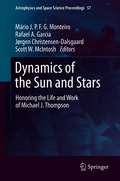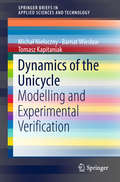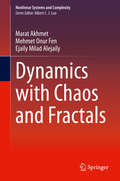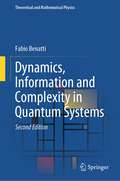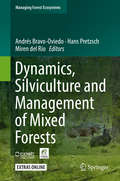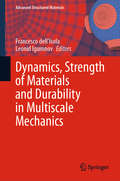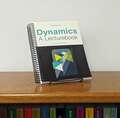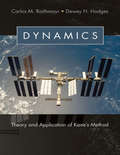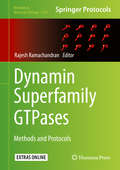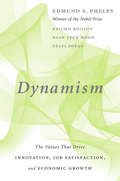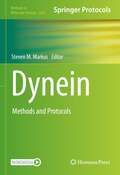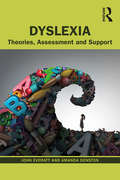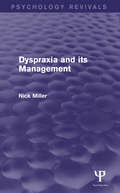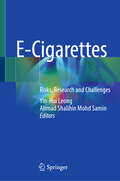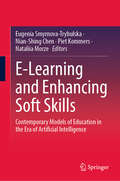- Table View
- List View
Dynamics of the Standard Model
by John F. Donoghue Eugene Golowich Barry R. HolsteinThis book gives a detailed account of the Standard Model of particle physics, focussing on the techniques by which the model can produce information about real observed phenomena. It opens with a pedagogic account of the theory of the Standard Model. Introductions to the essential calculational techniques are included. The major part of the text is concerned with the use of the Standard Model in the calculation of physical properties of particles. Rigorous and reliable methods (radiative corrections and nonperturbative techniques based on symmetries and anomalies) are emphasized, but other useful models (such as the quark and Skyrme models) are also described. The strong and electroweak interactions are not treated as independent threads but rather are woven together into a unified phenomenological fabric. Many exercises and diagrams are included.
Dynamics of the Sun and Stars: Honoring the Life and Work of Michael J. Thompson (Astrophysics and Space Science Proceedings #57)
by Rafael A. García Mário J. P. F. G. Monteiro Jørgen Christensen-Dalsgaard Scott W. McIntoshThese are the proceedings of a meeting celebrating Michael Thompson's seminal work on solar and stellar physics, as well as his major contributions to the development of the National Center for Atmospheric Research. The meeting also marked Michael J. Thompson’s untimely death in October 2018. Michael played a key role in the development of helioseismology and its application to the study of the structure and dynamics of the solar interior, and he provided a strong foundation for the extension of seismic studies for other stars. After focusing for several years on more administrative activities, he was returning to leading the seismic studies of solar interior rotation and he was deeply involved in the understanding of the dynamics of the core of stars, when his life was tragically lost. The conference focused on dynamical aspects of the sun and stars, based on the large amount of data available on solar and stellar oscillations, and the extensive and detailed modelling now becoming feasible. Combining observations, seismic analysis, and modelling the meeting and this book serve as a fitting memorial to a close colleague and friend, much missed.
Dynamics of the Unicycle: Modelling And Experimental Verification (SpringerBriefs in Applied Sciences and Technology)
by Tomasz Kapitaniak Michał Niełaczny Barnat WiesławThis book presents a three-dimensional model of the complete unicycle–unicyclist system. A unicycle with a unicyclist on it represents a very complex system. It combines Mechanics, Biomechanics and Control Theory into the system, and is impressive in both its simplicity and improbability. Even more amazing is the fact that most unicyclists don’t know that what they’re doing is, according to science, impossible – just like bumblebees theoretically shouldn’t be able to fly. This book is devoted to the problem of modeling and controlling a 3D dynamical system consisting of a single-wheeled vehicle, namely a unicycle and the cyclist (unicyclist) riding it. The equations of motion are derived with the aid of the rarely used Boltzmann–Hamel Equations in Matrix Form, which are based on quasi-velocities. The Matrix Form allows Hamel coefficients to be automatically generated, and eliminates all the difficulties associated with determining these quantities. The equations of motion are solved by means of Wolfram Mathematica. To more faithfully represent the unicyclist as part of the model, the model is extended according to the main principles of biomechanics. The impact of the pneumatic tire is investigated using the Pacejka Magic Formula model including experimental determination of the stiffness coefficient. The aim of control is to maintain the unicycle–unicyclist system in an unstable equilibrium around a given angular position. The control system, based on LQ Regulator, is applied in Wolfram Mathematica. Lastly, experimental validation, 3D motion capture using software OptiTrack – Motive:Body and high-speed cameras are employed to test the model’s legitimacy. The description of the unicycle–unicyclist system dynamical model, simulation results, and experimental validation are all presented in detail.
Dynamics with Chaos and Fractals (Nonlinear Systems and Complexity #29)
by Marat Akhmet Mehmet Onur Fen Ejaily Milad AlejailyThe book is concerned with the concepts of chaos and fractals, which are within the scopes of dynamical systems, geometry, measure theory, topology, and numerical analysis during the last several decades. It is revealed that a special kind of Poisson stable point, which we call an unpredictable point, gives rise to the existence of chaos in the quasi-minimal set. This is the first time in the literature that the description of chaos is initiated from a single motion. Chaos is now placed on the line of oscillations, and therefore, it is a subject of study in the framework of the theories of dynamical systems and differential equations, as in this book. The techniques introduced in the book make it possible to develop continuous and discrete dynamics which admit fractals as points of trajectories as well as orbits themselves. To provide strong arguments for the genericity of chaos in the real and abstract universe, the concept of abstract similarity is suggested.
Dynamics with Chaos and Fractals (Nonlinear Systems and Complexity #29)
by Marat Akhmet Mehmet Onur Fen Ejaily Milad AlejailyThe book is concerned with the concepts of chaos and fractals, which are within the scopes of dynamical systems, geometry, measure theory, topology, and numerical analysis during the last several decades. It is revealed that a special kind of Poisson stable point, which we call an unpredictable point, gives rise to the existence of chaos in the quasi-minimal set. This is the first time in the literature that the description of chaos is initiated from a single motion. Chaos is now placed on the line of oscillations, and therefore, it is a subject of study in the framework of the theories of dynamical systems and differential equations, as in this book. The techniques introduced in the book make it possible to develop continuous and discrete dynamics which admit fractals as points of trajectories as well as orbits themselves. To provide strong arguments for the genericity of chaos in the real and abstract universe, the concept of abstract similarity is suggested.
Dynamics, Information and Complexity in Quantum Systems (Theoretical and Mathematical Physics)
by Fabio BenattiThis second edition of Dynamics, Information and Complexity in Quantum Systems widens its scope by focussing more on the dynamics of quantum correlations and information in microscopic and mesoscopic systems, and their use for metrological and machine learning purposes. The book is divided into three parts: Part One: Classical Dynamical SystemsAddresses classical dynamical systems, classical dynamical entropy, and classical algorithmic complexity.Includes a survey of the theory of simple perceptrons and their storage capacity. Part Two: Quantum Dynamical SystemsFocuses on the dynamics of entanglement under dissipative dynamics and its metrological use in finite level quantum systems.Discusses the quantum fluctuation approach to large-scale mesoscopic systems and their emergent dynamics in quantum systems with infinitely many degrees of freedom.Introduces a model of quantum perceptron whose storage capacity is computed and compared with the classical one. Part Three: Quantum Dynamical Entropies and ComplexitiesDevoted to quantum dynamical entropies and algorithmic complexities. This book is meant for advanced students, young and senior researchers working in the fields of quantum statistical mechanics, quantum information, and quantum dynamical systems. It is self-contained, and the only prerequisites needed are a standard knowledge of statistical mechanics, quantum mechanics, and linear operators on Hilbert spaces.
Dynamics, Silviculture and Management of Mixed Forests (Managing Forest Ecosystems #31)
by Hans Pretzsch Andrés Bravo-Oviedo Miren Del RíoThe capacity of mixed forests to mitigate climate change effects by increasing resilience and lowering risks is pinpointed as an opportunity to highlight the role of tree species rich forests as part of complex socio-ecological systems. This book updates and presents the state-of-the-art of mixed forest performance in terms of regeneration, growth, yield and delivery of ecosystem services. Examples from more than 20 countries in Europe, North Africa and South America provide insights on the interplay between structure and functionining, stability, silviculture and optimization of management of this type of forests. The book also analyses the role of natural mixed forests and mixed plantations in the delivery of ecosystem services and the best modelling strategy to study mixed forest dynamics. The book is intended to serve as a reference tool for students, researchers and professionals concerned about the management of mixed forests in a context of social and environmental change.
Dynamics, Strength of Materials and Durability in Multiscale Mechanics (Advanced Structured Materials #137)
by Francesco Dell’Isola Leonid IgumnovThis book reviews the mathematical modeling and experimental study of systems involving two or more different length scales. The effects of phenomena occurring at the lower length scales on the behavior at higher scales are of intrinsic scientific interest, but can also be very effectively used to determine the behavior at higher length scales or at the macro-level. Efforts to exploit this micro- and macro-coupling are, naturally, being pursued with regard to every aspect of mechanical phenomena. This book focuses on the changes imposed on the dynamics, strength of materials and durability of mechanical systems by related multiscale phenomena. In particular, it addresses: 1: the impacts of effective dissipation due to kinetic energy trapped at lower scales 2: wave propagation in generalized continua 3: nonlinear phenomena in metamaterials 4: the formalization of more general models to describe the exotic behavior of meta-materials 5: the design and study of microstructures aimed at increasing the toughness and durability of novel materials
Dynamics: A Lecturebook
by Charles M. Krousgrill Jeffrey F. RhoadsThis hybrid of textbook and lecture notes set is designed to provide an undergraduate-level, engineering-focused introduction to the topic of dynamics. To this end, the text covers the following key topical areas: Particle and Rigid Body Kinematics, including Cartesian, path, polar, and cylindrical descriptions of motion; relative and constrained motion; vector kinematics; instantaneous centers of rotation; and 2D and 3D moving reference frames. Particle and Rigid Body Kinetics, including Newtons Laws of Motion; the work-energy equation; and the linear and angular impulse-momentum equations. Introduction to Mechanical Vibrations, including equation of motion development; free vibration response; harmonic forced vibrations; base excitation; and rotating imbalance, all as applied to single-degree-of-freedom systems. The text provides pertinent background information, while emphasizing fundamental engineering principles, conceptual understanding, and optimal problem solving techniques. The Lecturebook also incorporates an extensive array of practical examples with which students can hone their skills. Key distinctions between the Lecturebook and most conventional texts include: Complete integration of factual information and student-produced notes. Removal of extraneous factual information. The inclusion of conceptual problems designed to exercise higher levels of learning. Lecture example, homework solution, and demonstration videos designed to aid asynchronous learning. The hybrid textbook/lecture note format provides most factual information in full, while brief and extended examples are provided with ample white space, allowing students to actively work the problems with the instructor s assistance in a classroom environment, or outside of the classroom on their own or with the assistance of online videos.
Dynamics: Theory and Application of Kane's Method
by Dewey H. Hodges Carlos M. RoithmayrThis book is ideal for teaching students in engineering or physics the skills necessary to analyze motions of complex mechanical systems such as spacecraft, robotic manipulators, and articulated scientific instruments. Kane's method, which emerged recently, reduces the labor needed to derive equations of motion and leads to equations that are simpler and more readily solved by computer, in comparison to earlier, classical approaches. Moreover, the method is highly systematic and thus easy to teach. This book is a revision of Dynamics: Theory and Applications by T. R. Kane and D. A. Levinson and presents the method for forming equations of motion by constructing generalized active forces and generalized inertia forces. Important additional topics include approaches for dealing with finite rotation, an updated treatment of constraint forces and constraint torques, an extension of Kane's method to deal with a broader class of nonholonomic constraint equations, and other recent advances.
Dynamin Superfamily GTPases: Methods and Protocols (Methods in Molecular Biology #2159)
by Rajesh RamachandranThis volume provides methods and protocols on dynamin superfamily GTPases. Chapters are divided into three parts; detailing expression, purification, initial biochemical steps, undescribed analytical techniques, and biophysical and cellular characterization of DSPs in membrane remodeling, fission and fusion. Written in the highly successful Methods in Molecular Biology series format, chapters include introductions to their respective topics, lists of the necessary materials and reagents, step-by-step, readily reproducible laboratory protocols, and tips on troubleshooting and avoiding known pitfalls. Authoritative and cutting-edge, Dynamin Superfamily GTPases: Methods and Protocols to ensure successful results in the further study of this vital field.
Dynamische Chemie
by Georg SchwedtWas passiert beim Erhitzen eines kohlensäurehaltigen Mineralwassers? Wie viel Ascorbinsäure (= Vitamin C) ist im Apfel? Wie verändert sich der pH-Wert beim Lösen von Brausetabletten? Was passiert während der Gärung?Stets spielen chemische Gleichgewichte (und deren Verschiebungen, u. a. durch pH-Änderungen), Oxidationen und Reduktionen eine Rolle. Als wichtiges Hilfsmittel für die insgesamt 131 Experimente werden Teststäbchen verwendet, die in kürzester Zeit halb-quantitative Analysen ermöglichen. Auf diese Weise lassen sich auch Reaktionsverläufe erfassen ebenso wie Lösungs- und Fällungsreaktionen. Das Verstehen-Lernen chemischer Reaktionen steht im Vordergrund aller Experimente. Dem Kapitel Gleichgewichtsreaktionen folgen Redox-Reaktionen am Beispiel von Kupfer, Eisen, Ascorbinsäure, Sulfit/Sulfat und Nitrit/Nitrat. Den chemischen und enzymatischen Reaktionen von Glucose ist ein weiteresKapitel gewidmet. Gleichzeitig wird die chemische Fachsprache erläutert und geübt. Ein Muss für jedes Schülerlabor, engagierte Lehrer und jeden an Chemie Interessierten: das Buch hilft beim Erlernen und der Verinnerlichung der chemischen Denkweise.
Dynamism: The Values That Drive Innovation, Job Satisfaction, and Economic Growth
by Edmund S. Phelps Gylfi Zoega Raicho Bojilov Hian Teck HoonNobel Laureate Edmund Phelps and an international group of economists argue that economic health depends on the widespread presence of certain values, in particular individualism and self-expression. Nobel Laureate Edmund Phelps has long argued that the high level of innovation in the lead nations of the West was never a result of scientific discoveries plus entrepreneurship, as Schumpeter thought. Rather, modern values—particularly the individualism, vitalism, and self-expression prevailing among the people—fueled the dynamism needed for widespread, indigenous innovation. Yet finding links between nations’ values and their dynamism was a daunting task. Now, in Dynamism, Phelps and a trio of coauthors take it on. Phelps, Raicho Bojilov, Hian Teck Hoon, and Gylfi Zoega find evidence that differences in nations’ values matter—and quite a lot. It is no accident that the most innovative countries in the West were rich in values fueling dynamism. Nor is it an accident that economic dynamism in the United States, Britain, and France has suffered as state-centered and communitarian values have moved to the fore. The authors lay out their argument in three parts. In the first two, they extract from productivity data time series on indigenous innovation, then test the thesis on the link between values and innovation to find which values are positively and which are negatively linked. In the third part, they consider the effects of robots on innovation and wages, arguing that, even though many workers may be replaced rather than helped by robots, the long-term effects may be better than we have feared. Itself a significant display of creativity and innovation, Dynamism will stand as a key statement of the cultural preconditions for a healthy society and rewarding work.
Dynasties: The Rise and Fall of Animal Families
by Stephen MossFamily isn't just important. It's everything. From lions hunting as a pride to penguins huddling together to keep from freezing in the bitter Antarctic winter, many animals are dependent on complex social relationships for their survival. Powerful dynasties lay claim to vast swathes of territory, fighting off rivals and securing their hunting grounds for generations to come. Dynasties offers an immersive insight into the shifting hierarchies of animal families. Each chapter follows a different dynasty, from the Marsh Lions of the Masai Mara to rival packs of painted wolves, from a tiger protecting her newborn cubs to a chimpanzee troop and the penguin colonies of the Antarctic. Alongside tender moments when bonds are strengthened through grooming and play, the book charts the rivalries that tip the balance of power, when family members turn against each other and younger animals grow strong enough to challenge for control. With over 200 stunning photographs and insights from the crew of the BBC series, Dynasties reveals in astonishing detail the intricate social lives of our planet’s most fascinating animals.
Dynein: Methods and Protocols (Methods in Molecular Biology #2623)
by Steven M. MarkusThis volume provides a collection of protocols from leading researchers in the dynein field. The enclosed chapters guide readers through a broad range of powerful techniques that can be used to understand the complexities of dynein activity and regulation. These include how to perform live-cell microscopy on various fungi and metazoan cells, how to purify, assemble, and measure the force generation and motility characteristics of various dynein assemblies. Written in the highly successful Methods in Molecular Biology series format, chapters include introductions to their respective topics, lists of the necessary materials and reagents, step-by-step, readily reproducible laboratory protocols, and tips on troubleshooting and avoiding known pitfalls. Cutting-edge and thorough, Dynein: Methods and Protocols is a valuable resource for both novice and expert scientists in this developing field.
Dyslexia: Theories, Assessment and Support
by John Everatt Amanda DenstonDyslexia: Theories, Assessment and Support offers a broad perspective on dyslexia, providing a range of views from theory to practice which help explain the continued controversy surrounding the condition. Offering a framework on which to understand the concept of dyslexia, the book considers procedures that can both identify the condition and help support those with it. With a focus on self-concept, the authors highlight ways to positively influence both literacy acquisition and individual well-being. This book is ideal reading for those taking courses on dyslexia or literacy learning difficulties within education, psychology and related disciplines. It will be of great interest to specialist teachers, special education staff, educational psychologists and those in related occupations.
Dyson–Schwinger Equations, Renormalization Conditions, and the Hopf Algebra of Perturbative Quantum Field Theory (Springer Theses)
by Paul-Hermann BaldufThis book offers a systematic introduction to the Hopf algebra of renormalization in quantum field theory, with a special focus on physical motivation, the role of Dyson–Schwinger equations, and the renormalization group. All necessary physical and mathematical constructions are reviewed and motivated in a self-contained introduction. The main part of the book concerns the interplay between Dyson–Schwinger equations (DSEs) and renormalization conditions. The book is explicit and consistent about whether a statement is true in general or only in particular renormalization schemes or approximations and about the dependence of quantities on regularization parameters or coupling constants. With over 600 references, the original literature is cited whenever possible and the book contains numerous references to other works discussing further details, generalizations, or alternative approaches. There are explicit examples and remarks to make the connection from the scalar fields at hand toQED and QCD. The book is primarily targeted at the mathematically oriented physicist who seeks a systematic conceptual overview of renormalization, Hopf algebra, and DSEs. These may be graduate students entering the field as well as practitioners seeking a self-contained account of the Hopf algebra construction. Conversely, the book also benefits the mathematician who is interested in the physical background of the exciting interplay between Hopf algebra, combinatorics and physics that is renormalization theory today.
Dysphagia
by Olle EkbergThis book provides a comprehensive and up-to-date description of the diagnosis and management of dysphagia, with particular reference to oral and pharyngeal dysfunction. All aspects of dysphagia are covered, from anatomy and physiology to patient care. Alongside descriptions of a variety of disease entities, signs and symptoms, and treatment approaches, many other relevant topics are addressed, including endoscopic and manometric aspects, malnutrition and dehydration, the psychiatric burden, and features specific to pediatric and geriatric patients. The authors are without exception renowned experts in their field. This book will be of value to all specialists involved in the evaluation and treatment of dysphagia, including ENT surgeons, thoracic surgeons, speech and language pathologists, phoniatricians, gastroenterologists, neurologists, and radiologists.
Dysphagia Management in Head and Neck Cancers: A Manual and Atlas
by Krishnakumar Thankappan Subramania Iyer Jayakumar R MenonDysphagia and problems related to swallowing are common following treatment for head and neck cancers. Though there are books available on dysphagia management and associated neurological conditions, this is the only atlas that comprehensively discusses dysphagia related to the head and neck cancers. It comprises of 33 chapters divided into five sections. The initial chapters present the anatomy and physiology of swallowing and the pathophysiology of the dysphagia-related structures. It discusses assessment of dysphagia in detail, highlighting clinical and instrumental evaluations. Swallowing dysfunction related to common sub-site cancers and chemo-radiotherapy related dysphagia are explored individually. The book addresses direct and indirect swallowing therapy methods involving postures and exercises in a detailed yet simple manner to enable them to be incorporated in routine practice. It also covers topics like nutritional management, alternative feeding methods and unique problems associated with tracheostomy that have a great bearing on the day-to-day management of patients with dysphagia. The current status of the research and evidence- based management updates are also included. Additionally, where appropriate videos are included for a better understanding of the subject. Written and edited by experts in the field, the book is intended for clinicians treating head and neck cancer, head and neck surgeons, radiation oncologists, speech and swallowing therapy specialists and trainees in these fields
Dysphagia: Diagnosis and Treatment (Medical Radiology)
by Olle EkbergThe second edition of this well-received book provides a comprehensive and up-to-date description of the diagnosis and management of dysphagia, including oral, pharyngeal, and esophageal dysfunction. All aspects of dysphagia are covered, with detailed consideration of anatomy, physiology, and pathology. In addition to a variety of benign and malignant disease entities, signs and symptoms, and treatment approaches, many other relevant topics are addressed, including endoscopy, manometry, malnutrition, dehydration, oral care, dementia, ethics, and the social and psychologic impacts of dysphagia. Specific aspects of importance in pediatric and geriatric patients are highlighted. This edition features a number of completely new chapters focusing on, among other subjects, dysphagia in further disease contexts and following laryngectomy and radiation therapy. The authors are without exception world-leading experts in their fields. The book will be of value for practitioners in all specialties involved in the evaluation and treatment of dysphagia. It is therefore a truly multidisciplinary project.
Dyspraxia and its Management (Psychology Revivals)
by Nick MillerDyspraxia is a disorder of voluntary, purposeful, learned movement and is one of the most common sequelae of stroke, head-injury, neoplasm and abnormal ageing. It is also a major complicating factor in the assessment and treatment of acquired language, visual-spatial and other movement disorders. Dyspraxics are found not only in specialist neurological units, but also in rehabilitation centres, general medical and surgical wards, geriatric units and in the community. Despite this there was little systematic discussion of dyspraxia in major texts on stroke, head injury, rehabilitation or movement disorders at the time. Originally published in 1986, one aim of this book was to correct the imbalance in the attention paid to the disorder. The emphasis of the book is practical, dealing with the recognition and assessment of dyspraxic dysfunction, and guidelines and issues in its remediation. Theoretical issues are covered in relation to their bearing on clinical management. It was the standard textbook on the topic for many years and directly relevant at the time to clinicians in the fields of clinical psychology, occupational therapy and physiotherapy, speech therapy, neurology and geriatrics.
E-Cigarettes: Risks, Research and Challenges
by Yin-Hui Leong Ahmad Shalihin Mohd SaminThis book provides an overview of the diverse effects of electronic cigarettes (vapes) on human health and their regulatory concerns. It includes a thorough examination of e-cigarettes, covering their historical evolution, chemical composition, metabolomic analysis, health effects, regulatory landscape, and the concerning issue of e-cigarette or vaping-associated lung illness (EVALI) through compelling case studies. As the e-cigarette market constantly evolves, introducing new e-liquid formulations, the book addresses the rising challenges in regulation and monitoring. It also answers critical questions and serves as a reference for e-cigarette researchers and its broader societal implications.This book contains concise practical insights for physicians, toxicologists, and chemists. It is also relevant for public health experts, policymakers, tobacco-dependence treatment providers, tobacco control advocates/activists, health educators, and enthusiasts alike.
E-Commerce Law
by Paul ToddThis book includes detailed coverage of intellectual property, contract, encryption and liability issues, including allocation of domain names, use of metatags and other forms of search engine optimization, digital signatures and the position of ISPs and other intermediaries. There are case studies on electronic conveyancing and e-taxation. Though the book is written from a UK perspective, comparative material is included from other jurisdictions, including America and Singapore in particular.
E-Commerce und Datenschutzrecht im Konflikt: HMD Best Paper Award 2015 (essentials)
by Patricia LotzPatricia Lotz behandelt Rechtsfragen zum Einsatz moderner Marketingformen und gibt einen ersten #65533;berblick #65533;ber die Fallstricke, die sich dem E-Commerce in Zukunft vor allem im Bereich des Datenschutzes stellen werden. Die Autorin zeigt gleichzeitig m#65533;gliche L#65533;sungswege auf. Aus rechtlicher Sicht bespricht sie Webtracking, Geolokalisierung und Social Plugins. Zudem gibt sie eine #65533;bersicht #65533;ber die Integration von E-Payment-L#65533;sungen.
E-Learning and Enhancing Soft Skills: Contemporary Models of Education in the Era of Artificial Intelligence
by Piet Kommers Nian-Shing Chen Eugenia Smyrnova-Trybulska Nataliia MorzeThis volume E-Learning and Enhancing Soft Skills is a collection of articles by participants of the 16th annual scientific international conference “Theoretical and Practical Aspects of Distance Learning: E-Learning and Enhancing of Soft Skills. This conference, held on the 14th and 15th October 2024 in hybrid mode, is organized by the Faculty of Arts and Educational Sciences in Cieszyn, the Faculty of Social Sciences, the Institute of Pedagogy, the Faculty of Science and Technology, the Institute of Computer Science, University of Silesia in Katowice, Poland. Co-organizers and partners included: University of Ostrava (UO), Czech Republic, Silesian University in Opava (SU), Czech Republic, Constantine the Philosopher University in Nitra (UKF) Slovakia, University of Extremadura (UEx), Spain, University of Twente (UT), The Netherlands, Lisbon Lucíada University (LU), Portugal, Curtin University in Perth (CU), Australia, Borys Grinchenko Kyiv University (BGKU), Ukraine, Dniprovsk State Technical University (DSTU), Ukraine, IADIS - International Association for Development, of the Information Society, a non-profit association, Polish Pedagogical Society, Branch in Cieszyn, Polish Scientific Society for Internet Education, Association of Academic E-learning, Poland. Experts on e-learning from different countries provide insights into their studies, present their recent research results and discuss their further scientific work. The authors include experts, well-known scholars, young researchers, highly trained academic lecturers with long experience in the field of e-learning, AI and robotics in education, MOOCs, teacher training an area digutak and soft skills, m-learning, smart technologies, VR/AR; PhD students, distance course developers, authors of multimedia teaching materials, designers of websites and digital educational resources. This monograph therefore describes the theoretical, methodological and practical issues in the field of e-learning and the developing of key competencies and soft skills, contemporary models of education in the era of artificial intelligence, proposing solutions to important problems and showing the road to further research in this field. Built from the findings of an international retinue of scholars, this work will be of particular interest to academic researchers, educators, courseware designers, corporate trainers, and educational technology practitioners.

